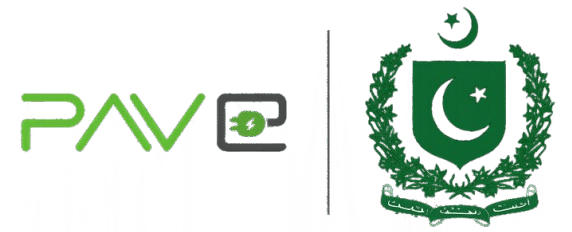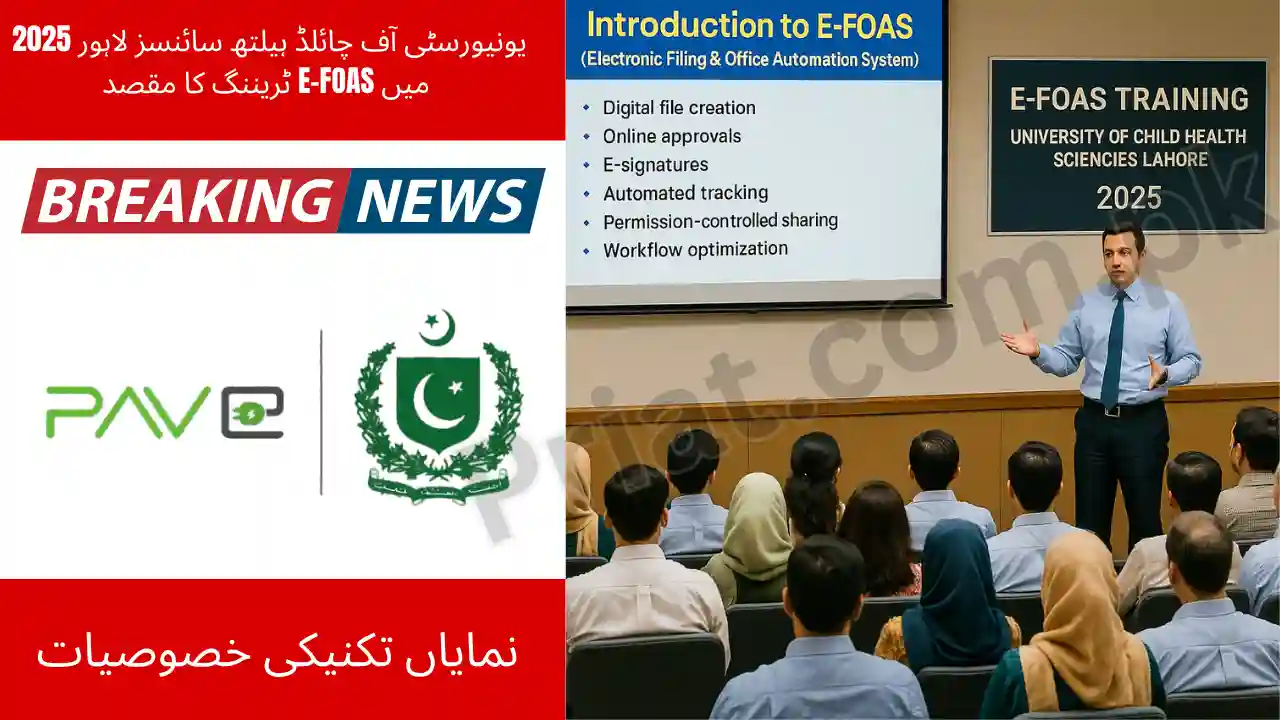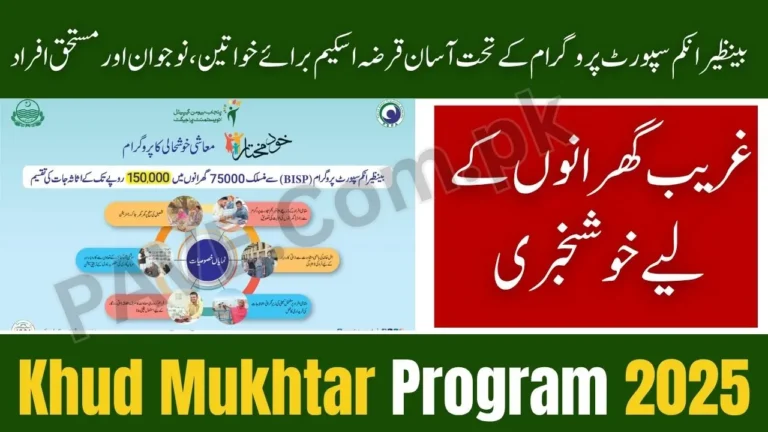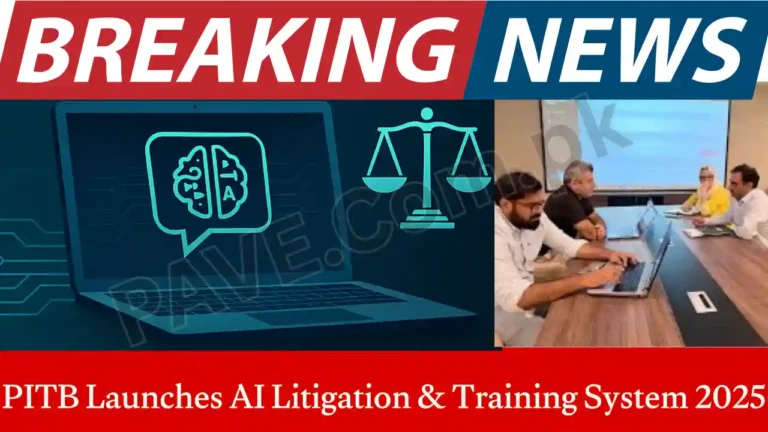E-FOAS Training Conducted at University of Child Health Sciences Lahore 2025
E-FOAS Training Conducted at University of Child Health Sciences Lahore 2025 is accelerating rapidly. One of the latest steps toward this modernization journey is the introduction of the E-FOAS (Electronic Filing & Office Automation System). To support seamless adoption and skill development, an important E-FOAS training session was conducted at the University of Child Health Sciences Lahore in 2025. This training aimed to educate participants about electronic documentation, file tracking, workflow automation, and digital approval mechanisms while reducing traditional paper-based practices.
The initiative demonstrates the government’s vision to implement a paperless, transparent, time-efficient, and secure digital filing system across educational, health, and administrative institutions. This fully digital filing system is supported by advanced software tools, secure data architecture, and centralized dashboard monitoring.
⭐ Introduction to E-FOAS (Electronic Filing & Office Automation System)
The Electronic Filing & Office Automation System (E-FOAS) is a modern digital platform developed to replace outdated manual documentation and file movement within government departments. It is designed under the supervision of top technology governance bodies to enhance efficiency, ensure documentation security, and introduce real-time accountability.
E-FOAS is equipped with:
- Digital file creation
- Online approvals
- E-signatures
- Automated tracking
- Permission-controlled sharing
- Workflow optimization
These features make it a future-ready administrative platform.
📌 Purpose of Conducting E-FOAS Training at University of Child Health Sciences Lahore 2025
This exclusive training session was not just an introduction but a hands-on professional capacity-building workshop. The training emerged as part of Punjab’s digital governance reforms.
The purpose included:
- Introducing university administrative staff to digital workflows
- Ensuring quick adoption of the new system
- Eliminating file loss, delays, and errors
- Enhancing departmental transparency
- Skill development in digital data processing
- Encouraging paper-free official communication
The University of Child Health Sciences Lahore was selected due to its administrative volume, medical academic operations, and student record management responsibilities.
🏛️ Why Digital Filing is Required in Educational & Health Institutions?
Manual documentation is slow, expensive, and vulnerable to:
- File misplacement
- Duplication of tasks
- Unnecessary delays
- Human error
- Manipulation risks
- Lack of transparency
With thousands of medical students, faculty, patients, and administrative operations daily—digital transformation becomes essential.
E-FOAS is therefore ideal for handling:
- Student records
- Procurement approvals
- HR documentation
- Clinical research documents
- Internal memos
- Budget requests
- Project proposals
⚙️ How E-FOAS Improves Operational Efficiency
The system simplifies workflows by allowing:
✔️ Automated forwarding
✔️ Centralized file monitoring
✔️ Direct communication between departments
✔️ Digital signatures for approvals
✔️ Real-time notifications
This reduces dependency on physical movement of files, which traditionally causes bottlenecks.
Read Also: BISP 8171 CNIC Check 2025
🖥️ Technological Features Highlighted During the Training
Participants learned about various advanced E-FOAS functionalities, including:
- Digital dashboard navigation
- File lifecycle timeline
- Priority tagging
- Document version control
- Role-based access permissions
- Audit trails for every action
- Electronic stamping
For higher-level users, the platform offers administrator rights to define user roles and departmental hierarchies.
🏫 Training Structure at University of Child Health Sciences Lahore 2025
The training included:
📍 Session 1: Introduction & Live Demonstration
Participants were shown how a digital file originates and flows between authorities.
📍 Session 2: Department-Wise Use Cases
Various academic and administrative departments learned how to integrate E-FOAS for:
- HR facilitation
- Finance requisitions
- Clinical documentation
📍 Session 3: Hands-on Practice
Participants performed actual file creation and routing exercises.
📍 Session 4: Q&A with System Experts
Faculty and staff clarified technical challenges.
👨🏫 Attendees & Participation Response
Training participants included:
- Registrar office staff
- IT department members
- Administrative officers
- Academic coordinators
- Medical program managers
Feedback was overwhelmingly positive, highlighting:
✅ User-friendly design
✅ Speed and clarity of documentation
✅ Reduced dependency on physical files
🌍 Impact of E-FOAS on Institutional Transparency
Transparency is one of the biggest achievements of digital filing.
E-FOAS supports:
- Trackable approvals
- Timestamped actions
- Immutable audit logs
- Conflict-free documentation
Delays are instantly traceable to responsible personnel.
This discourages:
❌ Corruption
❌ Favoritism
❌ File manipulation
Check Also: Benazir Income Support Program New Registration Centers Announced Across Punjab 2025
📑 Medical Universities & Digitalization Challenges
Medical institutions have multiple layers of documentation:
- Academic
- Clinical
- Administrative
- Financial
- Research
Traditional systems overload staff. E-FOAS solves this by:
✔️ Rapid record retrieval
✔️ Safe digital archives
✔️ Remote workflow approval
📊 Benefits of E-FOAS Training Conducted at University of Child Health Sciences Lahore 2025 (6–7 Detailed Points)
- Time Efficiency
Reduces turnaround time for approvals and requests. - Zero File Loss Probability
Digital history prevents mismanagement. - Cost Reduction
Minimizes paper printing, couriering, and file movement expenses. - Centralized Control
University administrators get a unified control panel. - Professional Accountability
Clears responsibility trails and timestamps. - Eco-Friendly Operations
Supports sustainable campus culture. - Smart Decision-Making
Quick access to critical data enhances governance.
✅ Training Outcomes & Observations
The training improved:
- Inter-department coordination
- Staff digital literacy
- Approval efficiency
- Documentation discipline
University management appreciated the initiative and pledged full adoption.
📌 Future Roadmap of E-FOAS Implementation in Punjab Institutions
Post successful pilot results, authorities intend to:
- Expand deployment to all medical universities
- Implement in attached teaching hospitals
- Integrate student attendance and assessment records
- Connect HR, finance, and procurement departments
🔍 Challenges in E-FOAS Adoption
Every digital transformation faces transitional hurdles:
- Resistance to change by senior staff
- Initial learning curve
- Need for sufficient training hours
- Stable internet requirements
However, once adopted—the system becomes smooth and reliable.
📲 E-FOAS and Paperless Campus Vision
The government aims to reduce:
- File cabinets
- Paper archives
- Manual registers
This saves resources for:
- Medical facilities
- Laboratory development
- Research funding
🧑🏫 Importance for Students & Faculty
Although primarily administrative, students indirectly benefit:
- Fast transcript processing
- Quick grievance resolutions
- Timely notifications
- Transparent record handling
Faculty members enjoy faster:
- Leave approvals
- Research proposals
- Procurement requests
🌐 Role of University IT Directorate
The IT department ensures:
- User authentication
- System security patches
- Server maintenance
- Regular backups
- Helpdesk support
Their presence ensures smooth deployment.
🔏 Data Security Mechanisms in E-FOAS
The system offers:
- Multi-layer encryption
- Digital audit trails
- Role-based access control
- Secure file servers
No unauthorized access is possible.
👥 User Training Frequency & Expansion
Future training phases may include:
- Advanced usage modules
- Department-specific workshops
- Monitoring and evaluation training
Read Also: Ehsaas 25000 Payment November 2025 CNIC Check, Status Update & Eligibility Alert
💡 Conclusion:
The E-FOAS Training Conducted at University of Child Health Sciences Lahore 2025 stands as a significant landmark in Pakistan’s march toward a digital governance ecosystem. It represents an entirely new operational culture where clarity, accountability, and efficiency replace outdated manual processes.
This training empowered university administrative teams with modern workflow management skills. Participants learned practical methods to delegate responsibilities, track documentation flow, and eliminate bottlenecks caused by physical file movement.
Furthermore, the session reinforced the government’s vision to construct paperless environments across academic and medical institutions. This indicates that Pakistan’s higher education sector is entering a digital maturity phase aligned with global industry standards.
The University of Child Health Sciences Lahore hosted this training efficiently, demonstrating leadership in adopting progressive systems. Their pro-digital stance ensures that future challenges—such as increased student enrollment and administrative load—will be handled with smart digital solutions.
Over time, the continued deployment of E-FOAS will significantly reduce operational costs, prevent documentation errors, and accelerate approvals for multiple academic workflows. It will eventually create a digital heritage archive for institutional memory.
Overall, the initiative is a shining example of how modern administrative tools can transform traditional bureaucratic systems. The training session will be remembered as an important milestone in institutional digital transformation and administrative excellence.
❓ Top FAQs E-FOAS Training Conducted at University of Child Health Sciences Lahore 2025:
Q1: What is E-FOAS?
An electronic filing and office automation platform for digital file management.
Q2: Why was the training conducted at University of Child Health Sciences Lahore?
To digitally enhance administrative efficiency and document transparency.
Q3: Who attended the training?
Administrative staff, IT members, academic coordinators, and officers.
Q4: Is E-FOAS easy to learn?
Yes—its interface is user-friendly and intuitive.
Q5: Does E-FOAS reduce file processing time?
Yes, real-time approvals speed up documentation significantly.
Q6: Can E-FOAS store student records?
It supports academic documentation storage.
Q7: Is the platform secure?
It uses encryption and access roles for high-security control.
Q8: How does the training help faculty?
They can manage requests, approvals, and proposals digitally.
Q9: Is paperless documentation mandatory?
It is strongly encouraged under digital transformation vision.
Q10: Will more training sessions take place?
Yes, expansion phases are planned institution-wide.







